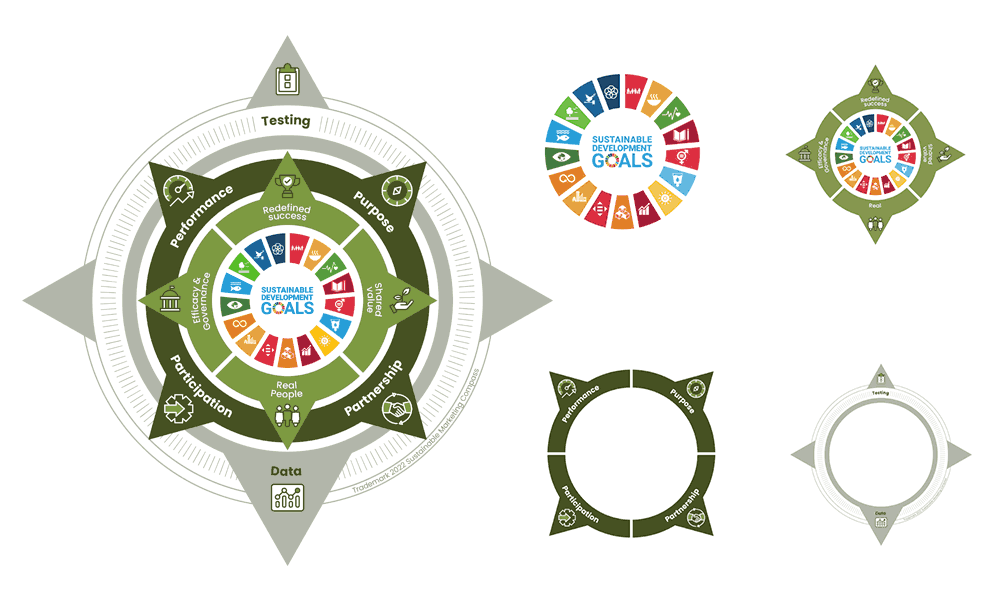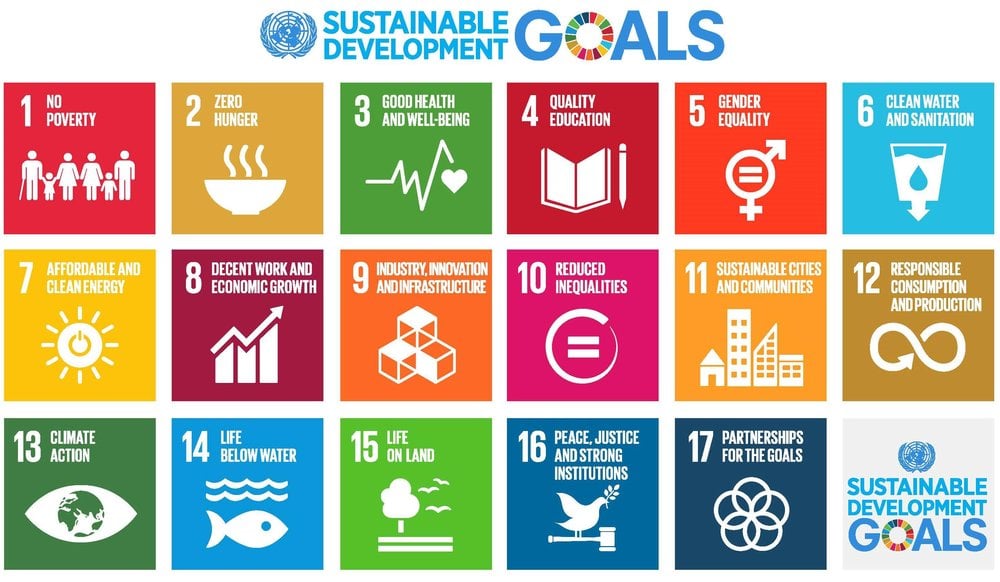Sustainable Digital Marketing: Redefining Success

Is digital marketing still fit for purpose? In this post, we explore why rethinking digital marketing is long overdue. We also share how you can redefine success by adopting more sustainable digital marketing practices into the new year and beyond.
I recently finished reading Paul Randle and Alexis Eyre’s book, Sustainable Marketing: The Industry’s Role in a Sustainable Future. It’s a useful resource for anyone tasked with helping organizations meet their marketing goals while also prioritizing positive social and environmental impact. Anyone in marketing should read it.
For purpose-driven marketers, its stakeholder-fueled recommendations are familiar territory:
- They suggest using the U.N. Sustainable Development Goals as the basis for defining an organization’s purpose and adopting success criteria.
- Shared value—the act of creating meaningful value beyond simply profit—is core to their hypothesis.
- Similarly, marketing should serve as an engine of well-being rather than solely a driver of commercial growth.
Unfortunately, as an industry overall, marketing doesn’t currently address the points above in meaningful ways. For decades now, marketing’s sole focus has been to drive growth while simultaneously externalizing social and environmental impacts. This drives multiple challenges and needs to change.
Digital marketing has similar issues, though different indicators are at play. The discipline’s sometimes questionable success criteria, approach to privacy, and low performance rates no longer serve the needs of many organizations (despite what many digital marketers might tell you).
So, what can we do about this?
Transforming Digital Marketing: Mindset Shift Required
Sustainability is about ensuring every single function within a company works towards long-term health and wellbeing for all and, at the moment, marketing is currently sitting miles behind every other function. This is not helped by the fact that many marketers don’t believe it needs to change.
— Paul Randle, Alexis Eyre
Unsurprisingly, marketing’s singular focus on commercial growth has come at great expense. We have crossed six of nine planetary boundaries. This has huge implications for communities and individuals living within ecosystems on the brink of collapse. What’s more, some of these breaches can directly be tied to marketing’s impact.
Similarly, because digital now influences nearly all marketing touchpoints, there is significant pressure for digital marketers to perform. In turn:
- We celebrate campaign success rates of less than 1-2% while overlooking the vast amount of waste created by our efforts.
- Our campaigns can destroy people’s privacy, tracking them across the internet in exchange for a fleeting—and often meaningless—opportunity to pitch our product or service.
- In turn, these and related issues contribute to the internet’s overall enshittification—or platform decay—which affects everyone who uses the web.
Does it need to be this way? Can we make marketing—and, specifically, digital marketing—a driver of social and environmental well-being rather than a tool to extract and exploit? Yes, we can. However, a transition to sustainable digital marketing requires a mindset shift on the part of not only marketing leaders but entire organizations. Are we up for the task?

Using Sustainability to Drive Digital Marketing
Traditional growth is still the master and the traditional role for marketing still governs the way that we are approaching sustainability. We are approaching it in the same way that we approached digital. We believe that it will change the way that we do things, but not why we are doing them.
— Paul Randle, Alexis Eyre
To transform marketing, the authors note, we first need to rethink our ‘why’. As noted above, they suggest using the U.N. Sustainable Development Goals to define marketing’s purpose and success criteria. These 17 goals represent the world’s collective best effort to address many of humanity’s biggest challenges.
Also, these goals—and their 169 associated targets—have been ratified by nearly 200 countries around the world. They’re a good place to start when rethinking marketing…and business in general.
However, digital marketers are often tasked with just a subset of an organization’s overall marketing. A company’s larger strategy—possibly still focused on outdated growth models—could restrict digital marketing from reaching its full potential. This transformation can be especially challenging if the organization outsources its digital marketing efforts to, say, an agency, freelancer, or other third-party supplier.
To work around this shortcoming, digital teams should incorporate the SDGs, or related frameworks, into collaborative strategy, discovery, or product roadmapping workshops as they define campaigns and projects. Part of this discussion will include redefining marketing’s mission within the organization, so be sure to include the right stakeholders in these workshops.
Marketing’s New Duty-of-Care
To this end, Sustainable Marketing’s authors propose a wholesale redesign of marketing’s mission to focus on three key things:
- Environmental: Marketing should protect the environment and aid its restoration through responsible consumption, production, and respect for the true value it delivers.
- Social: Marketing should also help humans fulfill their potential in dignity, equality, and in a healthy world.
- Commercial: Marketing should partner with people to shape behavior that supports new emerging economic models.
As a Certified B Corp, we’re all in on this. Unfortunately, many organizations have not considered expanding marketing’s mission beyond growth, let alone set their marketing departments up to achieve success via this expanded definition. Transformation doesn’t happen overnight.
Plus, in my experience, this is antithetical to how many marketers think, especially digital marketers, whose relentless attention to interaction data in the service of measurable growth can sometimes cause them to lose focus of bigger issues related to their work.
Practically speaking, what does this new duty-of-care really mean for digital marketers? What are the tactics we might employ to redefine our discipline both within the industry at large and for the organizations with which we work?
In the next section, we’ll cover some practices and processes to help you make a sustainable digital marketing transformation.

Sustainable Digital Marketing: Practices and Processes
This transformation from a finance to a wellbeing-oriented economy can’t succeed or accelerate without marketing as the conduit between companies and stakeholders at the helm. If companies are society’s innovation workshop, then marketing is the set of tools inside.
— Alexis Eyre, Paul Randle
First, marketing and sustainability teams within organizations need to work together to make sustainability core to the entire organization. This includes combatting greenwashing, adopting circular production methods for products and services, and crafting communications strategies based on honesty, transparency, and environmental/social/governance (ESG) principles.
Next, if marketing’s purpose is to advance well-being and build the Impact Economy, how should we rethink or redesign digital marketing so it’s fit for this task? Here are a few ideas. This is by no means a comprehensive list.
Fit for Purpose: Five Digital Marketing Practices to Double Down On
Individual organizations will need to figure out what works for them under this new duty-of-care based on their own structure, capacity, and priorities. For our purposes, here are five digital marketing practices that we think you should keep (perhaps with a few minor alterations).
1. Impactful content strategy based on human experience
Content strategy based on real human experience that focuses on the well-being of communities and ecosystems will continue to be important and relevant. Solving specific problems people have will always be more useful than hastily-written blog posts solely intended to boost search rankings.
Also, the rise of generative AI makes storytelling based on real, human experience and insights all that much more valuable. This applies not only to telling your sustainability story, but your overall communications and marketing efforts as well.
Put simply: you have certain subject matter expertise and experience that others will find valuable. Share it in your content. Nothing new here, but it’s still surprising how many organizations don’t heed this advice.
Similarly, digital accessibility prioritizes universal access to information, which should be a core component of any content strategy. Accessibility and sustainability complement one another as part of your organization’s overall approach to content.
Finally, good content governance—the act of measuring and managing content over time—is critical to nurturing a sustainable content strategy.

2. In-person collaboration
How might digital marketing support real human connection instead of replacing it? In-person collaboration can be more meaningful and productive than using digital tools as a means to the same end. Plus, people generally learn better in person.
While both approaches have their place—especially in a post-COVID-19 world—fostering collaboration through workshops, exercises, and events builds community and creates strong interpersonal connections.
This doesn’t have to replace existing digital marketing efforts, but it can help you improve communication and focus on quality over quantity. Also, there are ways to incorporate digital experiences into in-person collaboration through digital whiteboards, polling and networking via mobile apps, digital ESG dashboards, and other means.
Good collaboration based on shared learning experiences can help you build stronger relationships with customers, partners, and other stakeholders. Let’s put this at the heart of digital marketing.

3. Search Engine Optimization (SEO)
Due to its focus on continuous improvement and long-term gains, SEO aligns well with sustainability principles. However, like many other digital marketing practices, SEO has also been co-opted to game search engines, spread mis/disinformation, trick people, and undermine personal privacy.
These deceptive design patterns are inconsistent with making the web better for everyone. The risk is particularly high with the advent of artificial intelligence. However, sustainable SEO that focuses on aligning good search engine optimization practices with clear sustainability goals can help people quickly find the information they are looking for while also minimizing the social and environmental impact of search.
4. Strategic partnerships
Digital marketers regularly forge partnerships for content creation, link exchanges, podcasts, webinars, and so on. Why not expand these partnerships to include clear sustainability goals and benchmarks as well?
To do this, consider the following:
- Review your digital supply chain, identifying partnership opportunities that reduce risk, improve equity, diversity, and sustainability, and generally build digital resilience.
- Find ethical agency partners for specialty practices outside your areas of expertise, like ad management, SEO, email marketing, analytics, or community-building activities.
- Focus on scope 3 emissions, which come from your supply chain and represent the majority of marketing-related emissions.
- Choose more sustainable marketing tools when creating and executing digital campaigns.
Also, partnerships can take many forms. Be sure to consider other important stakeholders beyond just vendors and suppliers as part of this process—like customers, nonprofits, or other players in your business ecosystem. See the collaboration and research sections in this post for more information.
5. Testing & continuous improvement
Most digital marketing efforts already focus on incremental improvement via ongoing campaign measurement and benchmarking. However, campaign measurement usually involves just a few marketing metrics driven by specific growth goals.
By also incorporating sustainability metrics like carbon emissions, performance, privacy, and accessibility, marketers can execute more responsible digital campaigns. Performance dashboards or digital product passports can make this task easier for all marketing stakeholders.
With that being said, if A/B testing or other existing methods aren’t producing desired results, consider pivoting to something more useful. When doing this, be sure to delete expired data, clean up old code, and remove outdated content. Otherwise, unintended consequences like technical debt could occur.
Not Fit for Purpose: Let’s Rethink These Digital Marketing Practices
There are many risks and potential pitfalls in sustainable digital marketing—greenwashing being at the top of this list. Plus, digital marketers often limit their focus to the interactions of a specific target user type. This can cause us to miss important touch points in our campaigns’ broader stakeholder ecosystem.
Let’s rethink the tactics below to better support communities and ecosystems in the service of digital marketing.

1. User research
Your business is a complex network of customers, partners, beneficiaries, contractors, employees, communities, and other key players. User experience is a critical component of this ecosystem. However, we can’t focus only on target user needs at the expense of others.
Understanding how stakeholders beyond primary target users might be impacted by product, service, campaign, or program decisions you make can ward off potential unintended consequences while also adhering to marketing’s new duty-of-care.
Stakeholder mapping can help with this. Many digital marketers already incorporate user research into existing processes. Stakeholder mapping takes this process further by expanding our definition of who or what is important in digital marketing.
Pro tip: when running stakeholder mapping exercises, be sure to include non-human stakeholders—like the environment—as part of the discussions.
2. Personas
While personas are technically part of user or customer research, they’re worth including as their own category here for several reasons:
- Proto-personas (sometimes called lean personas) can be useful to quickly understand basic customer needs. However, marketers must prioritize inclusion and continuous learning as part of the process. This includes validating proto-personas with qualitative research.
- More importantly, personas depersonalize real people, creating two-dimensional portraits that usually leave out important aspects of their behavior, psychology, and needs.
- Personas also reinforce confirmation bias and assumptions in product and marketing teams. This is dangerous and can lead to unintended consequences.
Instead, conduct interviews with a broader group of stakeholders for deeper insights. To prioritize inclusion, focus on personal motivations over demographics in these exercises.
Also, make this process ongoing so their perspectives are included in different iterations of your product or campaign over time, like wireframing or prototyping. See continuous improvement above.
3. Data strategies
While good measurement practices are crucial to digital marketing success, many marketers have wholly unsustainable relationships with their data. This leads to increased risk, security and privacy issues, and extensive digital waste, which contributes to greenhouse gas emissions.
However, it is possible to incorporate sustainability data into existing marketing measurement efforts and become a data-driven organization. Consider incorporating the following into your data practices:
- Data governance and ethics: Adopt a code of ethics that includes long-term data governance. Revisit and update this code over time to be sure it remains fit for purpose.
- KPIs: Rethink organizational data and metrics to include carbon and other ESG factors.
- Data disposal: Devise an organization-wide data disposal strategy that everyone can follow.
- Data training: Finally, build team understanding and capacity by offering data training sessions in a collaborative learning environment.
Like sustainability itself, adopting sustainable data strategies is a long-term effort that helps you improve performance and build capacity over time. You don’t set it and forget it.
4. Website redesigns
For many organizations, website redesigns typically happen every 3-5 years. These efforts are largely driven by sloppy content practices, nonexistent website maintenance programs, improper resourcing, and poor governance. All these things waste time, money, and resources. Worse, organizations start these efforts by issuing an RFP, which is not a sustainable business practice.
Conversely, sustainable web design focuses on continuous, measurable improvement using the least amount of resources possible. Digital marketers can adopt more sustainable web practices by:
- Rethinking a website’s purpose so it provides useful information that addresses specific pain points along a customer journey throughout their relationship with your organization—not just in the service of closing a sale.
- Incorporating long-term website support and maintenance practices that prioritize performance, accessibility, sustainability, data privacy, and so on.
- Continuously improve content, systems, features, and campaigns over time.
This might sound daunting. However, by shifting your team’s mindset and adopting the practices above, it is entirely within the reach of even small, resource-constrained organizations.
5. Email marketing
Email spam is a massive problem. Beyond the day-to-day annoyance of cleaning out your inbox, it’s a major source of hacks and malware. Plus, spam has a significant environmental impact as well.
To align email marketing with sustainability principles, consider incorporating the following:
- Content strategy: Align email campaign content with subscriber needs and interests. See content strategy above.
- Privacy: Make sure your list is opt-in only based on informed consent. Don’t add anyone to email marketing lists unless you have explicit permission to do so. Use non-intrusive pop-ups and a clear privacy policy to alert users to cookies and other potential privacy concerns. Respect users’ right to be forgotten by deleting their data when requested to do so. And of course, follow privacy regulations like GDPR, CCPA, and others.
- Accessibility: Follow the same accessibility guidelines in email campaigns as you do on your website.
- Performance & emissions: Optimize campaigns to reduce data payloads and choose responsible providers that also respect privacy and power their servers with renewable energy.
6. Artificial intelligence
AI already has a huge impact on marketing. It also has significant social and environmental impacts as well:
- Environmental: AI requires vast computing power, which destroys the environment through e-waste and other sources of pollution, water and resource depletion, and greenhouse gas emissions.
- Social: AI ‘hallucinations’ can spread mis/disinformation, which is already a major problem on social media and the web in general. Plus, privacy concerns arise when using personal information to train generative AI’s large language models (LLMs). This could put you at risk for significant fines if you inadvertently share personal data.
- Economic: AI-powered automation can put people out of jobs and expand inequality and the digital divide. Also, some AI data labeling positions don’t pay anywhere near a living wage.
Studies that explore these impacts are released more frequently as AI’s challenges come to light. Plus, search engines and other tools are getting better at recognizing AI-generated content. If you’re using AI to drive content marketing efforts, this could eventually result in future performance penalties. Again, see content strategy above.
Primary take-away: use AI responsibly and strive to understand how its impacts might affect your digital marketing efforts. Wholegrain Digital’s great guide to ethical use of AI can help.
7. Online advertising
Everything is so focused on clicks and eyeballs, and achieving the lowest possible price for the highest number of impressions. All of the incentives are misaligned to create a really unpleasant advertising experience.
— Amy Williams, Can Advertising Ever Really Be Good for the Planet?
Covering the full breadth of sustainability in online advertising is beyond this post’s scope. However, much of the internet is built on an advertising model, so ads aren’t going away anytime soon.
Plus, many of the recommendations in other sections of this post also apply here. To rethink digital advertising with sustainability in mind, first familiarize yourself with digital sustainability principles, then figure out how to weave impactful climate strategies and digital responsibility practices into all ad campaigns. If you need help, some of the responsible ad companies in this post can help.
Again, online advertising transformation won’t happen overnight. Start with low-hanging fruit, then commit to continuous improvement, adding resources and training over time to build capacity.

The Sustainable Digital Marketing Transformation We Need
Marketing has a key role to play in securing health and wellbeing for people and planet, yet the transformation required, mostly in our mindset, is significant. Marketers have an inbuilt adaptability, which equips us well for the future ahead of us, but unfortunately we lack the pace of change. It took arguably 10–15 years for digital to transform our industry. The sustainability challenges we face don’t give us that luxury of time. Commitment and pace of change are needed to avoid the very worst of climate change.
— Alexis Eyre, Paul Randle
Eyre and Randle’s book is a great resource to add to any marketing library. I’d love to also see practical guidance on how marketers can drive regulations necessary to hasten the transformation our industry (and society) needs. Good marketing is so adept at shifting mindsets and inspiring action. Why shouldn’t it also be used to drive regulatory improvements?
Recent legislative efforts on artificial intelligence, data privacy, climate disclosures, and greenwashing aim to improve each of these marketing-relevant areas. Additionally, marketers could support and promote regulations that reduce inequality, advance equity, improve data transparency, and address some of the legislative hurdles associated with several recommendations in this post.
Either way, marketing has an important role to play in our collective transformation to a better world. But we need marketers to get on board. You can read more about Randle & Eyre’s approach by purchasing their book or reviewing their four-step Sustainable Marketing Compass model.
Also, please consider reading our SDG Report below. We researched and interviewed dozens of companies to learn how they incorporate the U.N. Sustainable Development Goals into their own practices. As always, feel free to reach out with questions.
How do organizations really use the SDGs?
Check out our SDG Report to learn how others use the U.N. Sustainable Development Goals to create meaningful change in their organizations.
Download the Report


